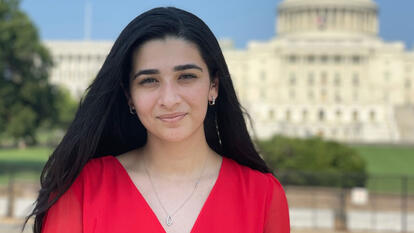
Will There Be More Earthquakes in Massachusetts? Anticipating the Future Through Sedimentology
Asked about almost any aspect of her field, Katrin Monecke, associate professor of geosciences, enthusiastically responds: “Oh, I love this!” For her, the study of the history and physical structure of the earth is a never-ending exercise in fascination.
Recently, her area of expertise became especially relevant for Massachusetts residents. Although Wellesley is located very squarely on what’s called the North American Plate, far from any fault lines, the ground there sometimes trembles. On November 8, residents of Wellesley and surrounding areas reported that the earth shook noticeably: A 3.6 magnitude earthquake was reported by the United States Geological Survey (USGS). “It’s unusual to have an earthquake here, but pressure still builds up from the plate movement and is released occasionally in these earthquakes,” Monecke explained.
The geosciences major at Wellesley, one of the first science majors offered by the College, dates back to the 19th century. Since then, thanks to satellites and digital imaging, the field has practically become an entire universe. “There was a time,” Monecke said, “when our field was called ‘geology.’ It was pretty straightforward, with mostly rock identification and geologic mapping—but now there is so much more!” The geosciences now encompass fields like oceanography, planetary geology, and geochemistry; geobiology and geomicrobiology, which deal with the biological processes of sediment formation; and even engineering geology, which involves making sure a structure’s foundation can sustain potential earthquakes. “The geosciences are really special because we draw from all the natural sciences: biology to recreate the fossil record, chemistry to look at minerals, physics to understand the propagation of seismic waves,” said Monecke. “What I love about it is that it’s so interdisciplinary.”
“The spatial scales and the time scales in the geosciences, even though I’ve read about it and I know how it works, still, to me, it’s mind-blowing.”
Katrin Monecke, associate professor of geosciences
Monecke’s specialty is sedimentology, in particular the study of lake and coastline sediment to find traces of past earthquakes. “Honestly, I love to study the lakes here,” she said. “Not many people have looked at the earthquake signature in the lake sediments. It’s like a detective story.” Lake sediments can be read like tree rings; year after year, deposits build up, often providing evidence of human history. Monecke gives the example of New England in the 1630s, when European settlers felled many trees, causing ragweed to overrun the area. Pollen from the plant blew into area lakes and settled, so that time period is very clearly identified in lake sediment. Seismology steps in at the point when earthquakes occur and lake sediment is shaken up and disturbed by underwater landslides. The ultimate purpose of this research is earthquake hazard assessment: to know the likelihood, frequency, and size of potential earthquakes. (Monecke recommends the book Timefulness: How Thinking Like a Geologist Can Help Save the World by Marcia Bjornerud to the amateur sleuth.)
The work doesn’t end there, however. “We can do all this science and understand the earthquake hazard better, but if we don’t communicate it well to those who must make a decision about the location of hospitals, large structures here and there, then it’s useless. We have to communicate the extent of the hazard to local decision-makers so that communities are better prepared,” Monecke said. In addition to her teaching and research, she is part of a U.S.-Canadian research collaboration studying the seismic hazard of eastern Massachusetts and refining regional earthquake hazard maps. The research is funded by the USGS Earthquake Hazards Program and is a collaboration between Wellesley College, Boston College, Salem State University, and Brock University in Ontario, B.C., Canada.
Although her travel is currently limited by the pandemic, Monecke, who has spent years studying the 2004 tsunami in Indonesia, is now planning a trip to Haiti. “The spatial scales and the time scales in the geosciences, even though I’ve read about it and I know how it works, still, to me, it’s mind-blowing,” she said.



